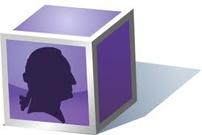
10. INFORMATION CUBES (Collaboration, Writing, Discussion)
Description: Information Cubes allow students to create a product using assigned roles within a group.
Application: Use when students are analyzing non-fiction text.
Process: Before using this activity for assessment, students should practice roles numerous times. Preview and select non-fiction resources on a specific topic for students or help students select their own resources. Introduce roles by distributing the role descriptions. Organize students into groups of four or five. Set time parameters and provide students with folders to keep information organized. Instruct students to join together and share their learning by creating an Information Cube, a six-sided cube that must include both text and visuals.
Suggested roles:
Data Digger: reads a section of the text to find interesting information and explains why each bit of information is important.
The Illustrator: reads the same section of the text and creates a visual representation via picture, cartoon, sketch, graph, chart, etc.; makes sure the visual(s) will fit on the cube; creates a side of the cube with a title and group members and role assigned.
The Questioner: reads the same section of the text and creates four or five questions based directly from the text; includes all levels of questions and provides at least one open-ended question; includes information on the cube.
The Summarizer: works closely with the Data Digger in order to make conclusions and summarize the information; makes sure information is included on the cube.
Word Warden: finds words that are not universally known to all; defines them and makes sure one side of the cube includes the words, with salient definitions. Have students present their cubes to the class.
Description: Information Cubes allow students to create a product using assigned roles within a group.
Application: Use when students are analyzing non-fiction text.
Process: Before using this activity for assessment, students should practice roles numerous times. Preview and select non-fiction resources on a specific topic for students or help students select their own resources. Introduce roles by distributing the role descriptions. Organize students into groups of four or five. Set time parameters and provide students with folders to keep information organized. Instruct students to join together and share their learning by creating an Information Cube, a six-sided cube that must include both text and visuals.
Suggested roles:
Data Digger: reads a section of the text to find interesting information and explains why each bit of information is important.
The Illustrator: reads the same section of the text and creates a visual representation via picture, cartoon, sketch, graph, chart, etc.; makes sure the visual(s) will fit on the cube; creates a side of the cube with a title and group members and role assigned.
The Questioner: reads the same section of the text and creates four or five questions based directly from the text; includes all levels of questions and provides at least one open-ended question; includes information on the cube.
The Summarizer: works closely with the Data Digger in order to make conclusions and summarize the information; makes sure information is included on the cube.
Word Warden: finds words that are not universally known to all; defines them and makes sure one side of the cube includes the words, with salient definitions. Have students present their cubes to the class.
Reference, photo credit, and/or for more information:
10. Information Cubes
http://www.readwritethink.org/classroom-resources/student-interactives/cube-creator-30850.html
10. Information Cubes
http://www.readwritethink.org/classroom-resources/student-interactives/cube-creator-30850.html
